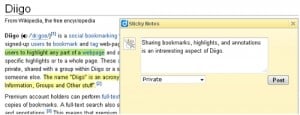 Whether you are writing a paper or article, planning a holiday, or checking house prices for your move to a new city, you are likely going to do an internet search using Google, Bing, or Yahoo, and then browse the search results yielding numerous web pages and forum discussions. Many of the pages contain some valuable information you will want to collect. While reading a page, you might come across important passages you want to highlight or annotate to capture your ideas related to that information.
Whether you are writing a paper or article, planning a holiday, or checking house prices for your move to a new city, you are likely going to do an internet search using Google, Bing, or Yahoo, and then browse the search results yielding numerous web pages and forum discussions. Many of the pages contain some valuable information you will want to collect. While reading a page, you might come across important passages you want to highlight or annotate to capture your ideas related to that information.
Consequently, during the course of your internet research, you are likely going to have visited anywhere between 5 and 100 different web sites.
No matter for what project you are doing your web research, you are going to face similar questions as to how to manage all this information:
- How do I collect all the information snippets from these web pages and create a summary report?
- How do I record the URL (web address) to remember the source along with the information snippet?
- How do I organize the information so that I can easily re-find it at a later time?
- If I am collaborating with other people, I additionally need an efficient way to share and update this information.
I have used various tools to tackle these questions and collect and annotate web resources, including Microsoft Word (with Dropbox), Microsoft OneNote, Zotero, and Evernote. They are all great tools and have their own particular strengths, so I am going to use future posts to share how I think we can make best use of them.
In this post however, I want to nudge you into trying a slightly different approach when doing your web research. Why? If you are anything like me, you are not going to use most of the web page snippets after collecting them. It is like clippings check in, but never out. What makes matters worse is that indiscriminate copying of web information drowns the real gems you have in your own personal information store.
What do I want you to try?
- Consider doing your initial research completely online directly on the world wide web, that is, organize (bookmark and tag), highlight, and annotate your web pages directly on the Internet. This will allow you to get an overview before you start collecting the pieces of information you deem important for your writing project or holiday trip.
- After having done your initial research, you will have a clearer picture of the topic and can decide which information you really need. In many cases, you may find that you have already achieved your goal, and a brief summary is all you need to take away from your research.
How to do it?
My favorite tool to accomplish this is the social research tool Diigo. Diigo stands for “Digest of Internet Information, Groups and Other Stuff”. After signing up for a free account at diigo.com, you can either use the so-called Diigolet (no installation, all web browsers), or the Diigo toolbar (add-on to Firefox or Internet Explorer) to bookmark, tag, highlight, annotate, and share web pages you come across. Here is how the toolbar looks on Firefox:![]()
- Bookmark and tag web pages to remember and organize them:

- Highlight the important parts of the pages you come across:
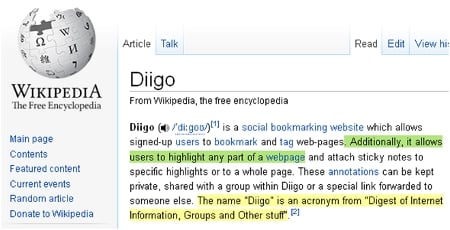
- Add sticky notes to web pages to comment or jot down your own ideas:
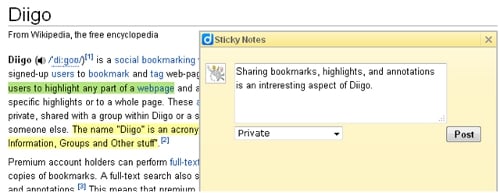
- Notes can be hidden under a speech bubble:

Where is my information, and what else can I do with Diigo? All your bookmarks, highlights, and annotations are stored and searchable in “My Library” in your account on Diigo’s web site. This also means, your information is available from basically any computer: You login to Diigo, start Diigolet, and surf the web with all your highlights and annotations turned on. In addition, you can decide to share selected information with the public and discover what others have shared. You can also join groups based on your interest, or create and manage your own groups to share your findings and work on a project in a team. You could for example create a group for a joint research assignment at school, university, or the office. A great aspect of using Diigo is the lively community of fellow users. You can join thousands of Diigo groups on about every topic under the sun or follow a particular person’s bookmarks and annotations.
How do I get my research out of Diigo? After your initial research, you can use My Library to go through the web page collection obtained through your research and select the pages you want to include in a summary.
- Go to My Library and select all web pages you want to include in your report:
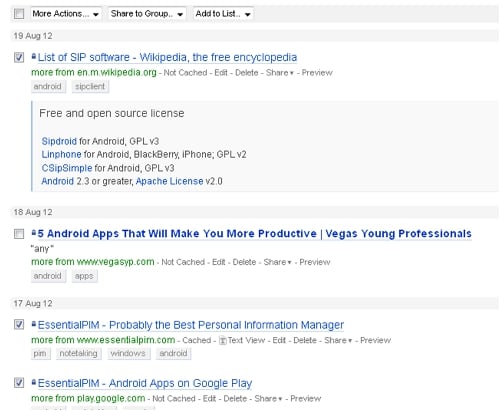
- Choose Generate Report from the menu More Actions:
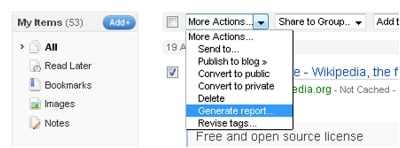 Diigo pulls out all highlights and annotations together with the source URLs and tags, and creates a report you can save on your computer. You can then take this summary report along on your holiday trip, or use it as input for a writing project.
Diigo pulls out all highlights and annotations together with the source URLs and tags, and creates a report you can save on your computer. You can then take this summary report along on your holiday trip, or use it as input for a writing project.
I hope, you have enjoyed reading this post and got some benefit out of it. Give Diigo a try, and you will not want to do your web research without it anymore. In an upcoming post, I will go into more detail on how to use Diigo for collaboration and sharing online research. Please stay tuned.
I would love to get your feedback. Please feel free to leave a comment below.
 10 simple actions that can double your productivity
10 simple actions that can double your productivity
FREE guide of my top productivity hacks for subscribers to my free newsletter

Great review…I’ve never heard of this and it seems like a good alternative to Evernote with the bonus of sharing and the community. Can’t wait to read your new book!
Hi Kenny, thanks a lot for your comment.
I use Diigo every day when reading forums and other discussions. It beats all other tools I have come across when it comes to distilling the information from multi-page threads. What’s more, it is one of a few tools that supports annotating of almost all web pages. A tool for learning and sharing rather than becoming a pack rat 😉
IMO, the main advantages of Evernote are
* It is available on almost all platforms.
* Great ability to render captured web pages.
I use Evernote to capture things I encounter throughout my day, but less to highlight and organize the Web.
I hope you’ll like my book. A review or feedback would be highly appreciated.
Have a great day,
Helmut
Great read, I like how you went through your process for using Diigo. It looks like a great tool for organizing information.